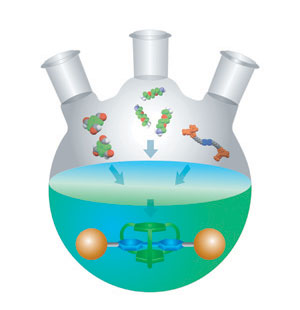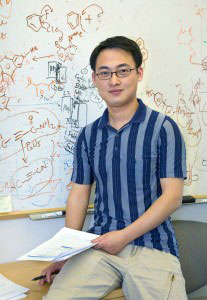| Posted: May 22, 2009 |
Quick-fix molecular machines |
|
(Nanowerk News) A sprinkle of this, a dash of that, sit back and let chemistry do its magic. Smells like a cooking analogy, but Berkeley Lab researchers have used just such a simple recipe to whip up ‘cage-like’ container structures to create complex molecular machines that can be programmed to rotate, switch and perform mechanical work.
|
 |
| Berkeley Lab researchers at the Molecular Foundry have developed a route to rapidly assemble 'cage-like' container molecules that could be used as molecular machines.
|
|
Previous research has shown efficient synthetic techniques can be used to construct complicated molecular machines that function by moving the individual parts within an overall molecular architecture. An example of this is a rotaxane-a complex molecule made of interlocking components that resemble wheels and axles. The tiniest building blocks in a scientist’s toy chest, these nanoscale parts ‘clip’ together to form functional molecular machines.
Unlike their macroscale counterparts, however, these interlocked molecules require no tinkering-”you can throw all the pieces together and let it assemble on its own,” said Yi Liu, a staff scientist in the Organic and Macromolecular Synthesis Facility in the Molecular Foundry, a U.S. Department of Energy User Facility located at Berkeley Lab that provides support to nanoscience researchers around the world. ‘The challenge is how to engineer a synthetic route to make the assembly happen on demand.”
|
|
|
|
Liu and colleagues have done just this, creating a caged structure made of benzene-like rings that assemble themselves around an axle of bipyridinium (a similar but positively-charged molecule containing nitrogen) to create an interlocked architecture (Linear -Acceptor-Templated Dynamic Clipping to Macrobicycles and [2]Rotaxanes). The cage itself could hold ions or small biological molecules, making it potentially useful for sensing applications.
“Our findings are especially attractive as the entire structure is formed through a ‘one-pot’ synthesis from six individual ingredients. Once the driving force, in this case the weak interactions between molecules, is identified, we can tailor the clipping to give us just the interlocked structure in an efficient manner, without undesirable polymer byproducts,” Liu said. “What could be simpler?”
|
 |
| Berkeley Lab researcher Yi Liu at The Molecular Foundry created a caged structure made of ring molecules that assemble themselves around an axle-shaped molecule. The cage itself could hold ions or small biological molecules, making it potentially useful for sensing applications.
|
|
The researchers anticipate the caged structure could be used as molecular containers for sensing, or as molecular switches by selectively sliding the cage along the axle, with ‘on’ and ‘off’ settings at either end. “The easy steps and simple precursors suggest these structures can be readily obtained in large-scale to support their applications,” Liu adds.
|
|
|
|
The Office of Science, Office of Basic Energy Sciences, of the United States Department of Energy, supported this work, under contract No. DE-AC02-05 CH11231.
|
|
The Molecular Foundry is one of the five DOE Nanoscale Science Research Centers (NSRCs), premier national user facilities for interdisciplinary research at the nanoscale. Together the NSRCs comprise a suite of complementary facilities that provide researchers with state-of-the-art capabilities to fabricate, process, characterize and model nanoscale materials, and constitute the largest infrastructure investment of the National Nanotechnology Initiative. The NSRCs are located at DOE’s Argonne, Brookhaven, Lawrence Berkeley, Oak Ridge and Sandia and Los Alamos National Laboratories. For more information about the DOE NSRCs, please visit http://nano.energy.gov.
|


